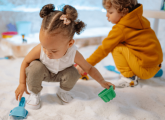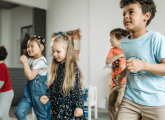Wendy Bowkett recalls the excitement a canvas roof and a ‘crackling’ campfire can generate in an early years setting…
Our campsite theme started one autumn afternoon when the rain was lashing down so hard that we couldn’t go out to play. We had planned to set up ‘camp’ with chairs and old blankets donated by a couple of grandparents of children attending our preschool. The blankets were thick, clean and warm but not waterproof! So we decided that a campsite indoors would be as much fun, considerably warmer and definitely drier!
Our original plan had been to have a bit of fun with makeshift tents in the garden. However, once the children realised we needed to clear some space within the nursery for our ‘campsite’, they thought there was a great deal to discuss. The children who had been on a camping holiday were full of suggestions as to what was needed for a great campsite as the idea was familiar to them. Within a few minutes the idea appealed to most of the children in the group and we, as a staff, realised that this was going to be more than a quick outdoor activity.
During the course of a week, parents and children collected and brought in catalogues, camping and gardening brochures and all sorts of (unbreakable) camping equipment for us to borrow. We utilised pans, plates and cutlery from the home corner, as well as blankets and play mattresses. We didn’t want to overdo the amount of props provided for the children, but these simple items often make for a richer imaginative play activity.
Tents were made with strong string strung from window ledges and chairs with blankets or fabric draped over and ‘pegged’ out with wooden building bricks. Other tents were blankets hung across chair backs and an A-frame (usually used for climbing). We made a couple of sleeping bags from old sheets in our fabric box and we had set up camp!
(Communication and Language; Literacy)
● We had played ‘When I went shopping, I bought a banana…’ many times and the children loved trying to remember all the items, so we altered the idea to involve a camping holiday. We sat around our camp fire and began: “When I went camping I took a tent/wellies/crisps,” etc. The list continued, not always remembered in order, but however impractical some of the suggestions seemed – e.g. a flagpole and a cow – each idea gave us opportunities to discuss a holiday in a tent. If a child could justify their reasons for taking an item along on the holiday, then that was fine with everyone. The flagpole was seen at a scout camp when one of the children had visited an older brother; we thought it a good idea because we would not get lost as the flagpole would show where our camp was. The cow was suggested by a child who had camped in the New Forest with her family and thought a cow was more useful than the horses roaming around! We lived in a farming community and children volunteered to milk the cow, so she came with us too.
TIP: Use small pictures of camping items from brochures stuck onto card and placed on the floor around the camp fire. They give children clues as to what they might take, or reminders of what has been mentioned already.
● Our campfire songs tended to be food-based, ‘10 Fat Sausages’ being the favourite, but we also changed the words to ‘Round and Round the Garden’ to become “Round and round the campsite, carefully we go, stepping over guy ropes, oh it is so slow.”
● Telling stories under canvas can be very atmospheric, so we often had our story time lying or sitting under our blanket tents, making up our own versions of ‘We’re Going on a Bear Hunt’ or ‘Dark, Dark Wood’.
● Having tents dotted around the room gave children wonderful opportunities to ‘chat in private’ with their friends. Eavesdropping is not necessarily a good idea, but it was quite enlightening and useful for record-keeping to listen to the children’s conversations, and the gossip and trivia they told each other, never thinking they could be heard outside the tent!
(Expressive Arts and Design)
● Make a montage of tents using folded paper covered with appropriate pictures cut from magazines.
● After talking about sleeping under canvas, why not paint on canvas? It’s a different experience from painting on paper, although not as cheap. Open a gallery and have an exhibition.
● Our campsite grew daily, with blue fabric laid down as a stream for fresh running water, tubes squashed and painted for a campfire with sugar paper flames, rocking boats for fishing trips and rope and pegs for drying wet clothing.
● Place a strip of self-adhesive magnetic tape to pieces of coloured fish-shaped card and attach a metal paperclip to a piece of string or wool to make a simple fishing game for an instant meal around the campfire.
● Try printing shapes using pieces of ‘guy’ rope (string) glued to bricks or pieces of wood as makeshift printing blocks. The patterns produced could be used to decorate your tents.
● Make lanterns from cardboard with orange or yellow tissue paper in the windows’. Light them up with a torch shining up from underneath.
(Understanding the world)
● Develop children’s observational skills by making a game of ‘Snap’ using matching photographs from camping brochures or catalogues and glued onto card. Collect sets of similar pictures. Or play ‘Spot the difference’ with the same cards, noticing guy ropes, awnings, etc.
● Promote choice making by talking about the best places for pitching a tent. What could happen if you set up camp at the bottom of a hill, on top of a cliff or mountain? Is a flat surface best?
● Introduce environmental concepts regarding keeping the campsite clean and tidy, safe for animals, birds and other people after you’ve gone home, recycling.
● Promote issues of health and safety while camping, e.g. campfires, tripping over guy ropes, washing hands after playing outdoors, etc.
● Create opportunities for using magnifying glasses and binoculars for bug and bird watching whether your imaginative play area is indoors or outside.
(Maths)
● Provide dark fabric or blankets for tents so that a dark interior can be used to feign night-time for a fun group activity. Hide one or two camping necessities inside the tent. Give a child a torch and clues as to what to look for inside the tent. Then count how long it takes for each child to find the items. Lift the flap a little to let in more light. Is it easier to find the missing objects? Count and see.
● Introduce the idea of estimating. How many children can hide underneath one blanket? If the same blanket is pegged to chairs, can more or less children fit underneath? Do you count children whose feet or backs show?
● Draw simple maps of the imaginative play area. How many tents can fit in the space? How close can they be before the space is overcrowded? If tents are back to back, is there more or less room?
● Make a number frieze of a drying line filled with sleeping bags. Use fabric to add texture and colour to each sleeping bag.
(Personal, emotional and social development)
● Encourage children’s understanding of their needs by chatting and listening to their ideas about the clothes they might require while camping. Have waterproofs and Wellington boots as props alongside thick woolly jumpers ready for cold nights and chilly mornings at your campsite.
● Use the opportunity of confined space in the tents to explore children’s feelings about sharing space and being very close to others.
● The children who were unfamiliar with camping were fascinated to realise there would be no TV or DVDs to watch in the tents. Several children mentioned that they had DVD players in their cars so they still watched cartoons and films. It wasn’t like that in the 60s or 70s!
● Cooking takes on a whole new meaning when camping – no ready meals in the microwave! Think about how to keep food and milk fresh without a fridge.
● Washing and teeth-cleaning is very different when a sink and running water are not necessarily available in your tent. How do you keep clean and healthy? How do you find the toilets in the dark? The children who had been camping came up with some very good ideas that made efficient use of fresh water, as well as the water left over from washing up.
(Physical development)
● Use a light fabric held at the corners by four children (like a gazebo tent). Flap it up and down gently, allowing other children to run underneath. Lay the fabric on the floor and swap places so that the gazebo ‘legs’ become the runners and vice versa.
● When the weather improved, we collected twigs and leaves from the garden to ‘add’ to our campfire, making it look very realistic.
● A definite outdoor activity was our ‘Wellie wanging’ competition. How far can you throw your wellie, and in which direction will it go?
TIP: Always ensure everyone stand well clear of this activity; preschoolers are not renowned for their skills when aiming, especially with Wellington boots. But it is a real fun activity whether camping or not!
Wendy Bowkett is an author and ran her own private day nursery for 15 years.

Sand and water table – Getting hands-on with maths
Editors picks

Early Years drama – Three simple games to play
Editors picks
